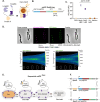Make-or-break prime editing for genome engineering in Streptococcus pneumoniae
- PMID: 40263274
- PMCID: PMC12015366
- DOI: 10.1038/s41467-025-59068-8
Make-or-break prime editing for genome engineering in Streptococcus pneumoniae
Abstract
CRISPR-Cas9 has revolutionized genome engineering by allowing precise introductions of DNA double-strand breaks (DSBs). However, genome engineering in bacteria is still a complex, multi-step process requiring a donor DNA template for repair of DSBs. Prime editing circumvents this need as the repair template is indirectly provided within the prime editing guide RNA (pegRNA). Here, we developed make-or-break Prime Editing (mbPE) that allows for precise and effective genetic engineering in the opportunistic human pathogen Streptococcus pneumoniae. In contrast to traditional prime editing in which a nicking Cas9 is employed, mbPE harnesses wild type Cas9 in combination with a pegRNA that destroys the seed region or protospacer adjacent motif. Since most bacteria poorly perform template-independent end joining, correctly genome-edited clones are selectively enriched during mbPE. We show that mbPE is RecA-independent and can be used to introduce point mutations, deletions and targeted insertions, including protein tags such as a split luciferase, at selection efficiencies of over 93%. mbPE enables sequential genome editing, is scalable, and can be used to generate pools of mutants in a high-throughput manner. The mbPE system and pegRNA design guidelines described here will ameliorate future bacterial genome editing endeavors.
© 2025. The Author(s).
Conflict of interest statement
Competing interests: J.W.V. is a scientific advisory board member at i-Seq Biotechnology. The remaining authors declare no competing interests.
Figures







Similar articles
-
Precision genome editing in the CRISPR era.Biochem Cell Biol. 2017 Apr;95(2):187-201. doi: 10.1139/bcb-2016-0137. Epub 2016 Sep 29. Biochem Cell Biol. 2017. PMID: 28177771 Review.
-
Harnessing CRISPR-Cas9 for Genome Editing in Streptococcus pneumoniae D39V.Appl Environ Microbiol. 2021 Feb 26;87(6):e02762-20. doi: 10.1128/AEM.02762-20. Print 2021 Feb 26. Appl Environ Microbiol. 2021. PMID: 33397704 Free PMC article.
-
A new inducible CRISPR-Cas9 system useful for genome editing and study of double-strand break repair in Candida glabrata.Yeast. 2019 Dec;36(12):723-731. doi: 10.1002/yea.3440. Epub 2019 Sep 5. Yeast. 2019. PMID: 31423617
-
Prime editing in bacteria with BacPE.Methods Enzymol. 2025;712:405-418. doi: 10.1016/bs.mie.2025.01.026. Epub 2025 Feb 20. Methods Enzymol. 2025. PMID: 40121080
-
CRISPR/Cas9 Technology in Translational Biomedicine.Cell Physiol Biochem. 2020 Apr 17;54(3):354-370. doi: 10.33594/000000224. Cell Physiol Biochem. 2020. PMID: 32298553 Review.
References
-
- Shapiro, R. S., Chavez, A. & Collins, J. J. CRISPR-based genomic tools for the manipulation of genetically intractable microorganisms. Nat. Rev. Microbiol.16, 333–339 (2018). - PubMed
-
- Tong, Y. et al. CRISPR-Cas9, CRISPRi and CRISPR-BEST-mediated genetic manipulation in streptomycetes. Nat. Protoc.15, 2470–2502 (2020). - PubMed
MeSH terms
Substances
Grants and funding
- 310030_200792/Schweizerischer Nationalfonds zur Förderung der Wissenschaftlichen Forschung (Swiss National Science Foundation)
- NCCR AntiResist 51NF40_180541/Schweizerischer Nationalfonds zur Förderung der Wissenschaftlichen Forschung (Swiss National Science Foundation)
- TMPFP3_210202/Schweizerischer Nationalfonds zur Förderung der Wissenschaftlichen Forschung (Swiss National Science Foundation)
- 771534-PneumoCaTChER/EC | EU Framework Programme for Research and Innovation H2020 | H2020 Priority Excellent Science | H2020 European Research Council (H2020 Excellent Science - European Research Council)
LinkOut - more resources
Full Text Sources

